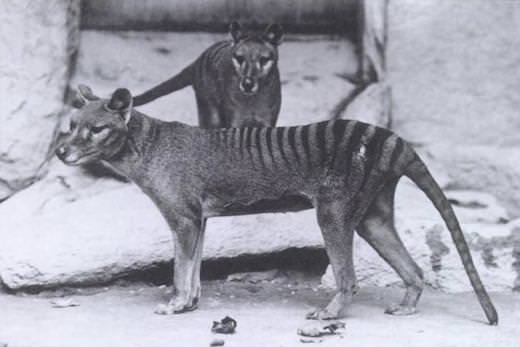Thylacine

Extinct 1936
The Thylacine, also known as the Tasmanian tiger or Tasmanian wolf, was a shy, nocturnal creature that held the title of Australia's largest predator until 3500 years ago. It had the general appearance of a medium to large sized dog, however, it had a stiff tail and an abdominal pouch. The tail, while stiff, extended smoothly from the body in a way that was similar to that of a kangaroo. It had a yellow-brown coat that had between thirteen and twenty-one distinctive dark stripes across its' back, rump, and along the base of its' tail. The stripes were more apparent in younger Thylacines and usually faded as they got older. The body hair was dense, but soft. They had rounded, erect ears. The female had a pouch that opened to the rear of its' body, with four teats. The Thylacine was one of two marsupials were both the male and female had pouches. The males pouch acted as a protective sheath, which covered his external organs. This protected him while he ran through thick brush.Their jaws were muscular, although very weak. The Thylacine was a formidable predator, which means it was able to survive and hunt prey in sparsely populated areas.
Habitat
The Thylacine was native to continental Australia, Tasmania, and New Guinea. There have been fossils uncovered at Riversleigh as well, so it is possible that they lived there too. There is not really much more known information about the Thylacines habitat.
Extinction
The Thylacine probably went extinct around 2000 years ago in mainland Australia and possibly even earlier in New Guinea. The Thylacines were drove to extinction by the adverse effect humans had on the environment, including the diseases they brought over. The Thylacines survived into the 1930's by inhabiting the island state of Tasmania, however, they were very rare by that time. The extinction of the Thylacines is most commonly blamed on hunting, competition with wild dogs, erosion of its' habitat, the extinction of prey species, and a distemper like disease. The last known wild Thylacine was shot in 1930 by a man named Wilf Batty. The last captive Thylacine was a male and died on September 7, 1936. It is believed that he died as a result of neglect. The Thylacine was officially declared extinct by the IUCN in 1982 and by the Tasmanian government in 1986.